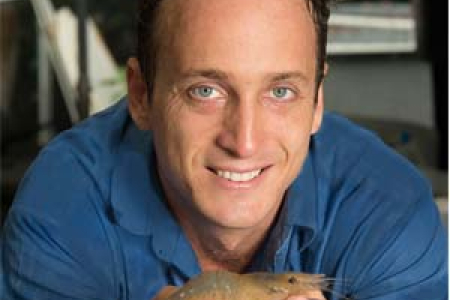Graduate discovers ‘key to cherabin survival’
A Charles Darwin University PhD graduate has been the first to follow the life cycle of an iconic freshwater prawn species, finding there is more to its fight for survival than previously thought.
With little known about the ecological role and life history of Macrobrachium spinipes, locally known as cherabin, and with concern that populations were declining, Peter Novak’s PhD research produced the first study on the life cycle of the species.
“To understand their natural history, we needed to find out more about their annual migration, and where and when they breed,” Dr Novak said.
He monitored a 400 kilometre stretch from Katherine to the mouth of the Daly River in the Northern Territory and through the Edith and Ferguson tributaries over a total period of more than three years, surveying more than 9000 adult prawns and millions of juveniles and larvae.
“We also collected females with egg clutches of ready-to-hatch larvae and tested the survival rates of the larvae in freshwater over a period of days in the lab,” he said. “We found that for a larva to survive it needed to reach the saltwater nursery grounds within seven days of hatching. Without their annual migration downstream this species would not survive.”
Dr Novak said the annual journey of larva downstream was in tune with river flow and season, along with moon phase and time of night. The migration began with the commencement of the wet season from December to March and persisted through to April/May.
“We found about 1000 kg (about 14 million) of juvenile prawns migrating upstream over about six weeks along with other iconic species like the barramundi and mullet,” he said. “The migration was like a replenishing of nutrients and food for the river system.”
To find out more he also looked at the habitat the prawns used during their life cycle. Most importantly he found that the habitat used by juveniles changed as the dry season progressed.
“Early in the dry season, just after they have migrated back upstream, the river bank with a large amount of cover (stick, undercuts, roots) was essential habitat, but as the dry season progressed algae and plants colonised the large sand banks within the river, which then became important habitat for the juveniles,” he said. “By the end of the dry season, the juveniles had grown or been eaten and rock bars and undercut banks become the favoured habitat of large, ready to reproduce males.”
Dr Novak’s research has provided valuable baseline data about the species that can now be used to improve management of cherabin populations in the NT.
“Now we not only know how important river flow is to the survival of these cherabin populations, but also how vital the species is in the linkage between freshwater and estuarine food webs,” he said. “Any developments that might impede the migratory behaviour of cherabin could have significant impacts at an ecosystem scale.”
Dr Novak will be conferred with a Doctor of Philosophy award at the CDU graduation ceremony this evening. His thesis was entitled: “The life history and ecology of Macrobrachium spinipes (Schenkel, 1902) in Northern Australia: Exploring hydrological connectivity through a model species”.
This project is supported by Charles Darwin University through its Research Institute for the Environment and Livelihoods, the Northern Australia Hub of the National Environmental Research Program, the Northern Territory Government Research and Innovation Post Graduate Scholarship, and Holsworth Wildlife Research Endowment.
